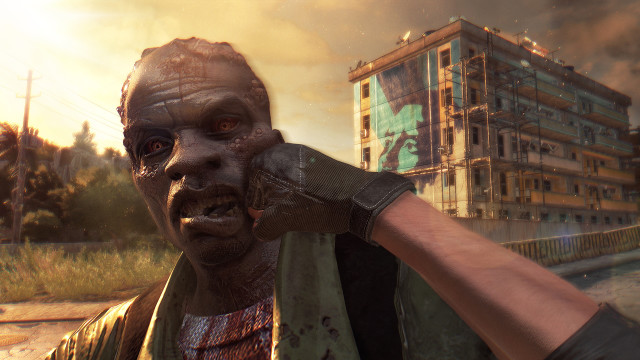
Despite the overabundance of zombie-related games, Techland made a name for itself with its 2011 release, Dead Island. It was an open-world action game with some light RPG elements, focused entirely on surviving the zombie hordes. Techland’s latest game, Dying Light, is similar in many ways, but focuses more on traversal and the survivalist aspects of Dead Island, making for a more self-serious experience. In some ways it surpasses Dead Island, but its shortcomings aren’t too dissimilar.
In the zombie-infested fictional city of Harran, you play as Kyle Crane, an American operative sent on a mission to stop a rogue agent and potentially save the city from the seemingly unstoppable outbreak. While Dying Light is more Walking Dead than Dawn of the Dead, its story is still mired in campy dialogue and over-the-top sequences that don’t match its tone one bit. Despite strong performances from the likes of Roger Craig Smith and Stephen Merchant, you’ll find yourself chuckling at the ridiculous narrative more than anything else.
Despite the lackluster story, Dying Light’s gameplay fits the game’s brooding tone rather well. If you’ve played Dead Island before, you should know exactly what to expect here. You are free to traverse Harran, fighting (or running from) various zombies, scavenging for resources and ultimately doing your best to survive. The most refreshing change is the movement, which allows for more freedom when escaping large swaths of undead. The game’s focus on parkour, which allows you to scale walls and buildings with relative ease, makes it that much easier to get away from a tough situation and is a welcome addition.
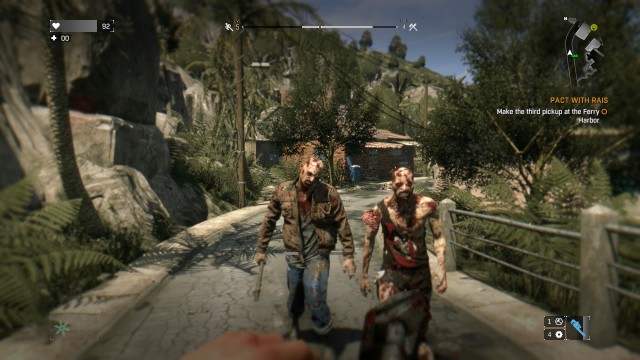
Weapon upgrades and malleability
It isn’t long before you can add special upgrades to your favorite weapons, including electricity, which stuns enemies, and toxicity, which poisons them. These upgrades give you a slight advantage in combat, especially against large waves of zombies, but since your weapons weaken over time and can eventually become irreparable, I never found myself utilizing them too often.
It can be finicky at times, and you may not always be able to climb something that seems easily climbable, but the feeling of speed as you jump from rooftop to rooftop makes for some exciting moments as you narrowly escape dire situations. It’s not a solution to every problem, especially when the zombies can sometimes gravitate toward you to grab you when you even get remotely close to them, but making running just as fun as fighting is a refreshing change of pace. The sense of mobility makes the zombie apocalypse seem manageable.
It’s not all about running away, however. When you are feeling brave enough to take on the undead directly, you’ll have to deal with Dying Light’s clunky combat. You have no real control over the swing of your weapon, simply the ability to attack, and this immediately gives you a less tactile feeling of control.
Since you’re dealing with zombies, attacks to the head are better than attacks to the body or limbs, but not being able to aim your attacks in any real way makes it feel like you are just wildly swinging your melee weapon of choice around without a care in the world. This becomes especially apparent when you throw other humans into the mix, as they can block and dodge your attacks, making those encounters last way longer than necessary.
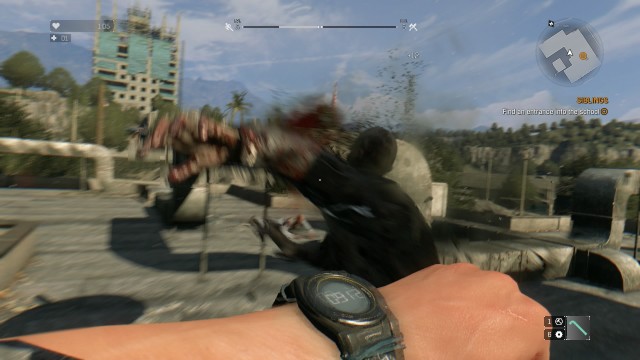
It wasn’t long before I began to dread combat entirely, avoiding it whenever I could. Your kick allows you to knock enemies back and you do have the ability to dodge when necessary, but the act of taking down enemies, whether alive or dead, never felt satisfying. Modifying weapons helped slightly, but when it came down to fighting more than two enemies at once, I always felt hopelessly outnumbered. That’s the point in many situations, sure, but it became apparent quickly how much better I would fare with combat that felt even remotely in line with the encounters I was coming up against.
Before long, I found myself less likely to run into a combat scenario and more likely to run from it. Traversing the world, foraging for resources and simply surviving are Dying Light’s strengths. This is where the day-night cycle comes into play. After 14 in-game hours pass, nighttime begins. It isn’t long before it’s pitch black outside and you are forced to fend for yourself against new, incredibly dangerous enemies known as volatiles. These guys are tough to take down and even tougher to run from, adding a surprising and tense element of stealth to an already packed game.
It’s recommended to take shelter during the night, and you are given a decent amount of warning beforehand, but you are rewarded with double experience when you explore at night, giving you plenty of incentive to test your skills. Being caught in the middle of the city when night comes around, suddenly surrounded by volatiles on the prowl, is terrifying. These moments where you are forced to rely on sneaking around the environment, instead of simply running away, change the gameplay up just enough to make it feel like a different experience.
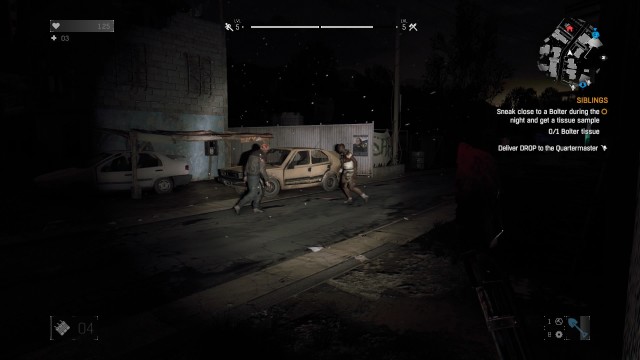
Be the Zombie
Once you pass a certain point early on in the campaign, you can play through the rest of the game in co-op with up to three other players. Co-op is exactly what you would expect it to be, but another multiplayer mode, creatively titled “Be the Zombie,” allows you to join other players’ games an infected. This isn’t a mode I expect people to continue playing much in the future, but it’s a fun twist on similar modes you find in games like Left 4 Dead.
A few of the main story missions, along with a good number of side quests, need to be completed at night, which forces you outside of your comfort zone and gives you ample opportunity to test your stealth skills. I found these to be the most exciting missions in the game, since they weren’t overly abundant and relied on a different skill set altogether. Unfortunately, most of the game’s missions tend to become repetitive fast, with not much balance between the day and night sections.
Once I started getting bored of the game’s melodramatic story, I also became bored of its mission structure. The core of Dying Light’s gameplay would make for an excellent ten-hour experience, but it goes on way longer than that. Even if you ignore all of the side content and focus entirely on the story, you’ll quickly learn its brand of variety is simply throwing different zombie types at you. This may seem like a good thing, but many of these encounters further extrapolate the problems with the combat. One mission in particular throws you into an arena and forces you to kill waves of zombies is the worst offender of this.
Thankfully, death is relatively painless in Dying Light. Sure, whenever you die, you lose some experience you gained, but whatever progress you made on your current mission — main story or otherwise — is saved like you had never died. Once I realized just how trivial death was, it made it much easier to charge into groups of enemies, take out a few, die and come back mere seconds later to kill more until I successfully completed my objective. I never felt like I was losing a ton of experience and, on top of how tedious it became over time, this discovery made the entire game feel less rewarding as a result.
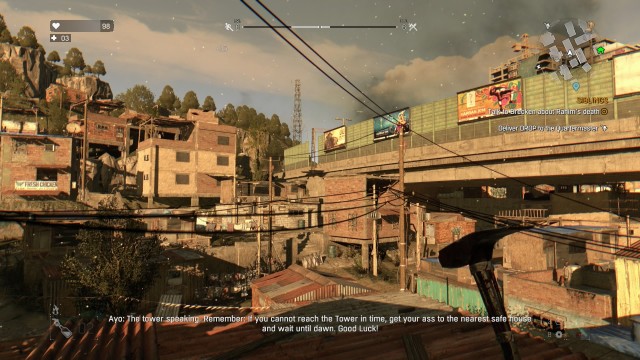
Dying Light is a game I desperately wanted to love. It seemed like it was taking the basic systems found in Dead Island and improving them in some meaningful ways. The day-night system made for some tense scenarios, and the traversal gave me more reason to flee than any other zombie game I had played. Once the difficulty ramped up and missions relied on combat over various other elements, though, its various problems became more apparent. Worst of all, it goes on way longer than necessary. Dying Light wants to be a fresh take on the Dead Island formula, but instead it’s as slow and shambling as its main antagonists.
Pros: Excellent traversal, day-night cycle adds a new twist, co-op is as fun as you expect
Cons: Awful combat, tedious mission design, laughably bad story



















